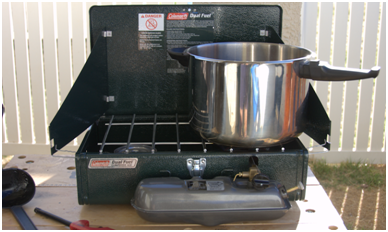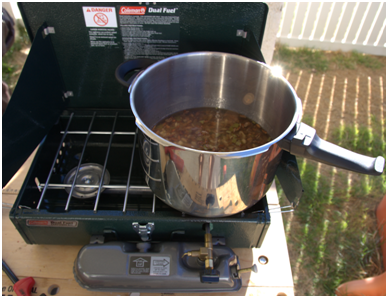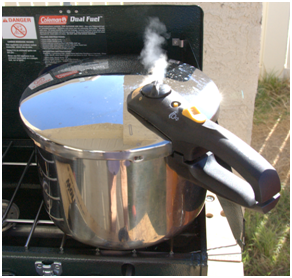A solid storage plan includes food, and also anything else you need to make the stored food into something edible. The difficulty is that none of the food storage guides or recipe books I have list how much fuel to store in order to make their recipes.
To rectify this, I have begun measuring fuel consumption when preparing recipes roughly as I would in no-gas and no-power emergency. Perhaps others will find this useful, and quantify their recipes.
The first step is to reduce the total fuel as much as possible, and the first target food is beans. Beans are a nice target because I have a lot of them—something like 15 lbs of kidney beans that are probably older than me. Furthermore, they offer excellent nutrition, and finally they cook for ages. The two techniques I know to reduce fuel use are pressure cooking and pre-soaking.
The test recipe today was for refried beans. The result was more delicious than any canned refries I have ever eaten, though the texture was much lumpier. The recipe is below. I cooked on my Coleman dual-fuel stove, using white gas. Cooking is performed in two stages, the first cooks the beans under pressure, and the second cooks the onions and “fries” the beans.
Total Fuel Use: 122 g (about 6 fl oz) of white gas
Pressure Cooking the Beans: 70 g (about 3.4 fl oz) of white gas
Refrying: 52 g (about 2.5 fl oz) of white gas
Pressure cooker seated on the stove in the back yard.

Pressure cooker loaded with the beans and other ingredients, prior to pressure cooking.

Pressure cooker at pressure; the heat is too high as shown by the copious steam jet.

Recipe
Adapted from Vickie Smith’s recipe for Refried Beans
Step 1
1 lb dried pinto beans, soaked at least 4 hours
4 cups pork or beef broth, stock, or water
Add beans and broth to pressure cooker, plus enough water to cover beans by about 2 inches. Stir to mix, lock the lid, and bring to pressure (15 psi) on high heat. Reduce heat to lowest setting that will maintain pressure, and cook for 12 minutes—I cook for 13 at 1 mile altitude. Remove from heat and let pressure drop naturally. Drain beans and mash them with a potato masher until they are to your taste in lumpiness.
Step 2
1/4 cup bacon fat
2 onions, finely chopped
1 mild poblano, pasilla, or Anaheim chile, seeded and chopped
2 cloves garlic, crushed
1 1/2 teaspoon ground cumin
Heat the fat in the pressure cook, add the onions, chiles, and garlic, cumin and cook, stirring, until they are very soft. Add the mashed beans in two or three batches, stirring to mix.

Comments
4 responses to “Food Storage and Refried Beans”
Using a pressure cooker certainly cuts energy usage. Glad to see that you are keeping track of that. Many people also don’t realize how delicious the food is when you pressure cook.
Thanks for the post.
When the swine flu hits, I’m goin’ to Park’s house.
Park,
I’d love you chat some time on this subject. Have you read Rawles’ book(s)/website? Do you plan on rice as well? To cover all the essential amino acids? Do you plan on just kidney beans and wheat or is this just a thought exercise? Is wood out of the question in your area? etc.. etc… Keep up the good work!
Started this reply once, and then somehow lost it. In any case, we store rice, but it hasn’t made the radar for writing about because it is a regular part of our diet–nothing too novel about it. I do need to perform the fuel experiments with rice, to complete the picture.
I haven’t read Rawles’ material at all, but will. Thanks for the pointer. Frankly, my storage horizon isn’t so long that I need to carefully balance the amino acids–beans are not complete there. For wheat I only store dried pasta and some modest amount of flour; I have no grinder and so storing whole grains is a non-starter.